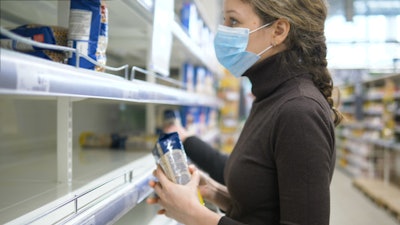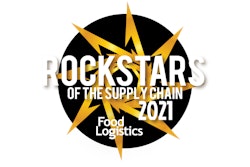
The food and beverage industry has faced excess inventory problems in the past, but never to the extent of its current reality amid the Coronavirus disease (COVID-19) pandemic. The magnitude of the predicament at hand is unlike anything seen before. While aligning inventory levels with fluctuating demand has always been a difficult task, managing excess inventory during a global pandemic is a more complex challenge. From food retailers to consumer packaged goods (CPG) companies, COVID-19 caught the entire food and beverage landscape completely off guard.
Here’s the unique aspects of the food and beverage industry’s excess inventory challenges, and what strategies must be implemented to navigate the future.
The ripple effects
Market volatility has strained food and beverage supply chains around the world. Before the pandemic, supply chains were structured to meet a steady demand. U.S. food spending had grown at a consistent 4% rate over the past five years while sales were evenly split between retailers and foodservice companies. With just-in-time delivery of goods at the wholesale level, grocers were able to carry less replenishment inventory and cut excess inventory volumes with supply chains that were ready for quick, albeit predictable, turnarounds.
COVID-19 challenged this dynamic. By March, forecasting for just-in-time deliveries was nearly impossible. Food spending in the United States grew by 29% from the previous year, as consumers panic-purchased essential goods and at-home consumption increased. Meanwhile, foodservice sales (restaurants, fast food chains, coffee shops, etc.) dropped by 27% over the same span and hit record lows when mandatory closings were enforced. In turn, foodservice suppliers were hit with sudden order cancellations across the board -- leaving them with excess inventory that couldn’t be easily redirected due to spoilage risks and package quantity mismatches.
The early stages of the pandemic produced a series of shockwaves that hit the entire food and beverage industry in multiple ways. For starters, the “bullwhip effect” caused by erratic volatility plagued supply chains around the world, creating communication gaps between distributors and retailers that led to critical disruptions and serious financial consequences. CPG supply chains were scrambling to meet the increased demand of specific products, only to see those same products become excess as demand swung in the opposite direction from one day to the next.
Food waste also became all the more prevalent. In April, the Dairy Farmers of America Association estimated that farmers were dumping 3.7 million gallons of milk every day into lagoons and manure pits because of disrupted supply chains. Crops went to waste as well, leading to irreversible financial losses and environmental damages to climate change. An Idaho farmer had to bury 1 million pounds of onions. One chicken processor had to smash 750,000 unhatched eggs per week. Farmers in South Florida had to plow ripe vegetables back into the soil. And, the list goes on.
Alongside its environmental effects, the high volumes of waste have threatened brand perception, especially in the eyes of Millennial and Generation Z consumers who were already willing to spend more money on sustainable products before COVID-19. The rise of consumer sustainability concerns over the last five years had shifted the industry’s mindset to a new cause-and-effect approach centered upon reducing carbon footprints to increase earnings. Now, as the pandemic has produced inflated amounts of additional food waste, reputations are taking a direct hit.
Companies that supplied staple products and frozen and shelf-stable goods were able to maintain steady sales inside supermarkets, while the farmers and distributors that previously relied on restaurant bulk buying struggled to remain afloat. In response, some farmers have implemented a localized direct-to-consumer (D2C) sales approach; eliminating their reliance on supply chains by cutting out the middlemen (restaurants, wholesalers, grocers and third-party sellers) and distributing their products directly to customers through e-commerce and social media. While the D2C model has helped them offset some lost profits, it certainly isn’t a viable long-term option.
Key lessons learned
If one thing’s for certain, the pandemic has proven that the food and beverage industry faces complex challenges both now and in an eventual post-pandemic environment. Fashion was in the same boat from an excess inventory standpoint, as erratic demand volatility left both industries with large volumes of excess inventory. However, while their root causes were the same, the outlook of that volatility is entirely different. Fashion has the flexibility to adjust to demand swings and shifting consumer behaviors because its volatility is seasonal and can be forecasted more accurately. Food and beverage volatility, on the other hand, is still highly difficult to predict as it changes week-to-week. Until a global vaccine is developed and distributed, the severity of the challenges won’t diminish for CPG companies and foodservice distributors.
There’s also a different type of risk for the food and beverage industry. First, fashion distributors can leverage the off-price markets and third-party companies that engage with consumers directly. And, while fashion retailers have the luxury of storing away items until next season, most food products -- especially raw goods that become processed -- do not have a flexible shelf life. More food and beverage waste is produced by unused excess inventory or products stuck in the supply chain.
In reality, the food and beverage industry’s future is dependent upon how quickly the pandemic subsides over the next year, and while these are challenging times, they also present unique opportunities. Now more than ever, organizations have an opportunity to embrace digitization. Finding simplified solutions to COVID-19’s complexities lies in digital innovation. The integration of advanced technology will be essential for successfully navigating life during and after the pandemic.
A shift to digital can enhance cross-team collaboration from each level of the supply chain. With sound continuity and transparency between manufacturers, distributors, transporters, foodservice companies and retailers, supply chain shortages could be identified earlier, allowing for a more effective and efficient response from farm to shelf. The industry also needs a firmer grasp on what products may or may not spike in demand, and how long that demand will exist. For example, the demand for toilet paper rapidly increased when the pandemic first started. Though after a few weeks, as fears of shopping in public began to subside, the demand took a steep decline. The companies who weren’t out in front of the sudden change ended up receiving the consequences of oversupplying.
The volatility will still exist after the pandemic, so maintaining agile operations and supply chain flexibility through digitization will remain essential. A dedicated software platform can help streamline internal workflows, improve cross-team collaboration and optimize inventory management for reducing costs. Advanced data analysis software provides real-time supply chain visibility, accurate forecasting and supply chain resiliency to combat ongoing volatility. And, last but not least, flexible e-commerce and omnichannel offerings from a robust digital selling platform can enable grocers to better handle rapid demand swings.
It’s no secret that the food and beverage industry has a long road ahead. Above all, its focus should be on controlling what can be controlled. By acting on lessons learned, developing a proactive business strategy and leveraging the use of advanced technology, companies across all levels of the food and beverage supply chain can adapt to the unexpected twists and turns of COVID-19’s New Normal.

















